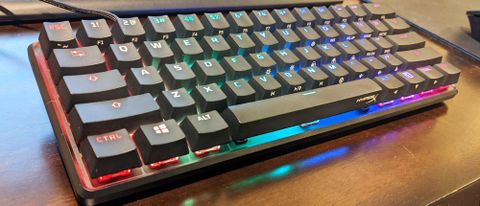Tom's Guide Verdict
While the HyperX Alloy Origins 60 is a little too small for seamless productivity applications, it’s a good gaming companion at a reasonable price.
Pros
- +
Tiny profile
- +
Comfortable key switches
- +
Pretty RGB lighting
- +
Sturdy design
Cons
- -
Not ideal for productivity
- -
Keys are a little loud
Why you can trust Tom's Guide
The HyperX Alloy Origins 60 is one of the best mini keyboards I’ve ever tried – even though I still couldn’t wait to put it aside once I was done. This tiny $100 peripheral perfectly captures both the conveniences and frustrations of the divisive mini keyboard design, but it does so with HyperX’s signature no-nonsense design philosophy. I can’t promise that you’ll like the Alloy Origins 60, but I can promise that if you have your heart set on a mini keyboard, it’s worth considering.
Like other HyperX keyboards, the Alloy Origins 60 has excellent key switches, a smart physical design, pretty lights and good-enough software. And, like other mini keyboards, the Alloy Origins 60 requires a sizable learning curve for anything outside of gaming. It’s a niche product, to be sure, but it’s a nice product done well.
It’s difficult to review a mini keyboard without evaluating the mini keyboard design itself, which is decidedly not for everyone. Still, the HyperX Alloy Origins 60 delivers where it counts, with great performance and solid build quality. If you’re willing to sacrifice 40% of your keyboard, the Alloy Origins 60 might be one of the best gaming keyboards (and best mechanical keyboards) you can get. Read our full HyperX Alloy Origins 60 review for the full story.
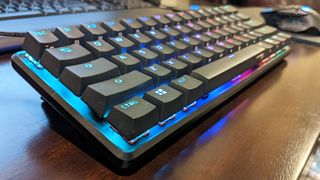
HyperX Alloy Origins 60 review: Design
To understand the HyperX Alloy Origins 60, it’s necessary to understand a bit of terminology first. The “60” in the product’s name refers to a “60%” keyboard design, which excises – you guessed it – about 40% of a traditional keyboard’s layout.
In general, the 60% design is an especially tough sell for touch typists and other full-size keyboard aficionados. Not only do you lose the number pad, discrete media controls and function keys; you also lose the arrow keys. When I first plugged in the Alloy Origins 60, I started missing the arrow keys right away – and even a full workday later, I still find myself reaching for them, especially while editing text documents.
Still, what the Alloy Origins 60 lacks is arguably not as important as what it possesses. This device is positively minuscule, measuring 11.5 x 4.0 x 0.5 inches. You can also prop the keyboard up at an angle, which increases the height a bit. Not only will the Alloy Origins 60 fit onto almost any desk you can imagine; it’s also extremely portable, thanks to a detachable power cable (USB-C to USB-A). If your built-in laptop keyboard is simply not cutting it, this is a very travel-friendly replacement.
The Alloy Origins 60 is also quite a sturdy device, with an aluminum frame and durable, matte keycaps. With almost no bezels and slightly elevated keys, the RGB lighting shines – literally – across the whole device. The keyboard is a little too plain to be described as “striking,” but it’s at least elegant.
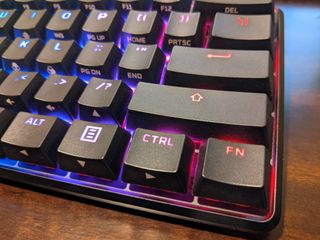
HyperX Alloy Origins 60 review: Keys
The HyperX Alloy Origins 60 employs proprietary HyperX Red key switches, which are linear. Red switches from competing manufacturers are often quiet as well, which is why it’s somewhat surprising that HyperX’s aren’t. They don’t generate the rapid-fire machine-gun noise of a Blue switch, but typing on them is still more reminiscent of a typewriter than of a membrane keyboard. Comparable switches from Cherry, Logitech and Razer all generate a lot less noise.
Still, sound is secondary to feel when it comes to keys, and the HyperX Reds feel pretty good. They don’t take much to actuate – 1.8 mm of distance and 45 g of force, to be specific – so gamers with a light touch should feel right at home.
Touch typists, on the other hand, are in for a bit of a rude awakening. Mini keyboards are, by design, a little more cramped than full-size models, and it makes substitution errors a lot more common. Using Typing.com’s one-minute test, I scored 114 words per minute with 98 percent accuracy. Compare and contrast to 125 words per minute with 99 percent accuracy on my usual Logitech G915. Even factoring in my familiarity with the latter device, it’s a noticeable difference.
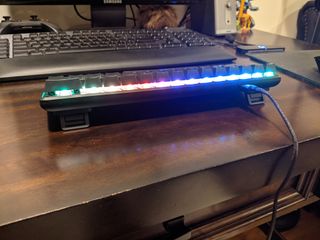
HyperX Alloy Origins 60 review: Features
The most noteworthy feature of the HyperX Alloy Origins 60 is its design. While HyperX previously collaborated with boutique Taiwanese manufacturer Ducky on the One2 Mini keyboard, the Alloy Origins 60 represents HyperX’s first solo outing. While mini keyboards from gaming manufacturers aren’t unheard of, they aren’t common, either. There’s something to be said for buying expensive hardware from a known entity with the backing of a big parent company.
Otherwise, good software is a boon for mini keyboards, since you’ll probably need to program a secondary set of commands to get the most out of one. By holding down the Fn key in the lower-right corner, you can access a whole keyboard’s worth of secondary features, from the function buttons, to media controls, to the much-missed arrow keys. But if you dive into HyperX’s Ngenuity software, you can reprogram every key, as well as every key’s secondary function.
The process here is remarkably straightforward. Simply open Ngenuity, select a key, and choose a function from a short series of menus. You can also disable custom key bindings, if you want to stick to what’s printed on the keycaps. While training yourself to learn two sets of key commands isn’t something that every user will want to do, this functionality makes it feasible for the Alloy Origins 60 to completely replace a full-size keyboard, rather than just supplement it.
The Ngenuity software also controls RGB lighting, but this offers a pretty standard array of features. You can have static lighting or various preprogrammed designs. The lighting is both bright and vibrant, but you can dim or deactivate it with a keyboard shortcut, if you’re so inclined.
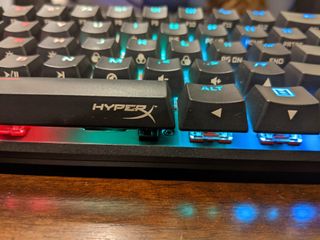
HyperX Alloy Origins 60 review: Performance
As is often the case for very small or very large keyboards, your preferred game genre can make a big difference in how a peripheral performs. I found that the HyperX Alloy Origins 60 was an absolute delight in Doom Eternal, for example, while it made Final Fantasy XIV somewhat harder to play than usual. I tested the keyboard with these games, along with Control and Age of Empires III: Definitive Edition, and the device had both charms and frustrations.
First and foremost, the Alloy Origins 60 demonstrates that mini keyboards can be a surprisingly good match for first-person shooters. With so few keys, there was nothing standing between my fingers and the bare necessities: movement, switching weapons and interacting with the environment. I can’t account for exactly why Doom Eternal felt so much more streamlined than usual, but focusing the keyboard helped to focus my inputs, too.
Final Fantasy XIV, on the other hand, was a bit of a chore. MMOs, including FFXIV, tend to require a lot of key combinations, particularly once you get to high levels, and need to switch among various skill trees rapidly. Not having a dedicated row of function keys slowed me down, as did the ever-present lack of arrow keys. I imagine MMO fans who like mini keyboards have already discovered workarounds for this issue, but it’s simply not an ideal match.
Control and Age of Empires III both functioned well, largely due to the HyperX Reds’ comfortable, responsive feel. The Alloy Origins 60 handles most games just as any other HyperX keyboard would, which is high praise.
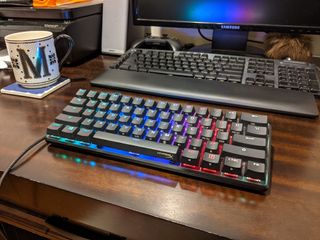
HyperX Alloy Origins 60 review: Verdict
The HyperX Alloy Origins 60 did not sell me on the mini keyboard design, and I’m beginning to doubt that any peripheral ever will. Losing almost half of the keys I’ve grown accustomed to is a very big ask, and I imagine a lot of other gamers will feel the same way. If you are at all uncertain about diving into the world of mini keyboards, know that your hesitation may save you from making a $100 mistake.
On the other hand, as mini gaming keyboards go, the Alloy Origins 60 delivers almost perfectly on its promise. It’s a well-built, no-frills device that does exactly what it’s supposed to do, without wasting a millimeter of space. It’s pretty to behold, and plays nicely with most game genres.
The Razer Huntsman Mini is also worth a look, although truthfully, I like HyperX’s layout and software just a little bit better. And if you’re not quite ready to take the plunge on a 60% keyboard, you could always split the difference with a TKL model.
Marshall Honorof is a senior editor for Tom's Guide, overseeing the site's coverage of gaming hardware and software. He comes from a science writing background, having studied paleomammalogy, biological anthropology, and the history of science and technology. After hours, you can find him practicing taekwondo or doing deep dives on classic sci-fi.
